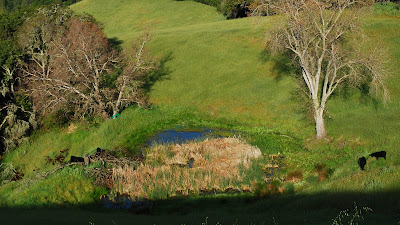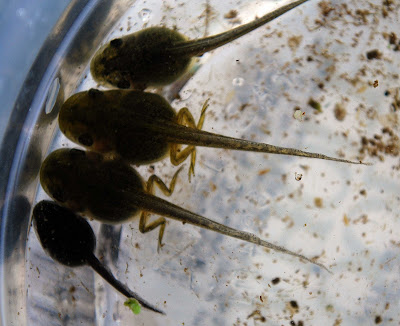The Pacific treefrog tadpoles spent the summer transforming into mini-frogs. Meanwhile, their name changed to Sierran treefrog.
A treefrog tadpole completes its aquatic life from egg through tadpole to small frog in about three months - longer, if water temperatures are cool. Depending on when the eggs where originally laid, treefrog tadpoles typically metamorphose in California from June to late August.

-- The Plum Pond on May 11th with visiting black cows. ---
As the summer flies by, the Plum Pond shrinks but still gets enough spring seepage that it does not completely dry up. Depending on their seasonal rotation, the cattle may drink from this and other ranch ponds as late as mid-July. Frogs are plentiful at the Plum Pond, although hard to find on hot days.
The Newt Pond dries up every year, sometimes filling and drying several times in the year. This year it dried up for good by June 7th which is 56 days later than last year. Earlier, in anticipation of its annual demise, I collected a few treefrog and toad tadpoles from the Newt Pond and have been raising them in a fish tank. Because of the cooler conditions in my kitchen, the tank tadpoles are developing more slowly than those in the Plum Pond.
 --- On June 13th in the kitchen tank, most of the treefrog tadpoles (top three) had legs,
--- On June 13th in the kitchen tank, most of the treefrog tadpoles (top three) had legs, but the California toad tadpole (bottom) did not. ---
In late May, the Plum Pond had treefrog tadpoles at several stages of development swimming about the warm, shallow water eating mostly algae. The youngest tadpoles had small rear limbs pushing out of the base of their tails. Frogs with larger legs used them to navigate through tangled vegetation.
On some Plum Pond tadpoles, the pair of front legs had burst out of a fold of skin in front of the belly. At this point, the tadpole is about to come out of the water and there are numerous internal changes also occurring. Its tail gets less finlike and more stump-like as it is adsorbed into the body. Lungs develop. The tadpole stops eating for a short time while its sucking mouth converts to jaws and its digestive system is converting from one that processes vegetable matter to one that breaks down animal matter.
 --- Suction mouth and big, shiny belly of a tadpole in the kitchen tank on June 13th;
--- Suction mouth and big, shiny belly of a tadpole in the kitchen tank on June 13th;it also has new rear legs and soon the front legs will push through the bulge in front of the belly. ---
 --- In the kitchen tank on June 26:
--- In the kitchen tank on June 26:left - newly metamorphosed treefroglet,
right - treefrog tadpole. ---
With all 4 limbs, the metamorph creeps out of the water, although it quickly leaps back in whenever disturbed. Over the next 5 or so days, the stumpy tail disappears completely. Initially, the froglet looks dark and skeletal, much smaller than the tadpole of a few days ago, probably due to its temporary fasting during metamorphosis.
 --- New treefrog at the Plum Pond on July 13th and only 3/8" from nose to rump. ---
--- New treefrog at the Plum Pond on July 13th and only 3/8" from nose to rump. --- --- The first treefrog to metamorphose in the kitchen tank is a rich copper color. ---
--- The first treefrog to metamorphose in the kitchen tank is a rich copper color. ---The young frog will use the suction-like discs on its toepads to climb pond vegetation where it will sit in wait for passing prey, mostly small, flying insects. If successful at its new hunting strategy, it will fill out into the more typical frog shape.
Some herpetologists have recommended reclassifying the Pacific treefrog because of differences in its body structure from the eastern treefrog, and also because of subtle differences between the populations throughout its California range, including something to do with those fancy toepads. For this blog site, I've committed to using the nomenclature and taxonomy for reptiles and amphibians as designated by the California Herps website because I think it's a good resource that stays current with the experts and particularly with field biologists working in California. While the tadpoles were transforming this summer, Gary Nafis converted to the new treefrog names on his website and I am too. See the California Herps website for more details on this name change and distribution maps.
See also:
Sierran treefrog, Pseudacris sierra - formerly called Pacific Treefrog, Pacific chorus frog, Hyla regilla or Pseudacris regilla.
California toad - Bufo boreas halophilus
Sierran treefrog, Pseudacris sierra - formerly called Pacific Treefrog, Pacific chorus frog, Hyla regilla or Pseudacris regilla.
California toad - Bufo boreas halophilus






SOOO cool! Great pics.
ReplyDeletethankyou... I was freaking out as what to feed my newly out of the water pacific tree frog... he is so tiny. Now that I know he won't eat today I feel releaved to know I have a day to collect food.
ReplyDelete